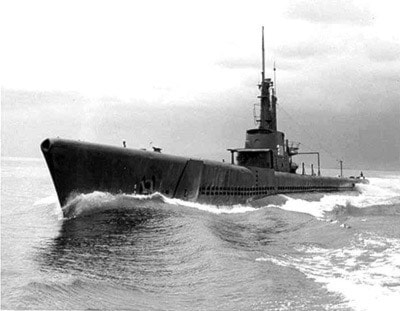“Nothing can sink Shinano,” barked Capt. Abe. “Continue course and speed.”
August 1967 marked the visit of the United States Navy Balao-class submarine USS Archerfish to HMC Dockyard, Victoria. Unknown to most, this aging non-nuclear submarine, a sister to the RCN’s HMCS Grilse, was the star of one of the most historic naval attacks of the Second World War.
In fact, she boasted three unique distinctions. She was then the only hydrographic survey vessel in the USN; she logged up to 5,000 miles in a single month so every one of her crewman was a bachelor; she sank one of the largest warships in naval history.
Commissioned Sept. 4, 1943, at Portsmouth, N.H., she began her first war patrol four months later, out of Pearl Harbour. Exactly a year to the day of the laying of her keel, Lt.-Cdr. G.W. Kohl successfully stalked a 5,000-ton Japanese freighter off Formosa and scored his ship’s first strike.
Her second patrol, 42 days off Palau Island, was uneventful. But Archerfish’s third sweep, now under command of Lt.-Cdr. W.H. Wright, resulted in an impressive total of one 800-ton coastal defence craft sunk, a 10,000-ton transport and a second, unidentified vessel damaged despite heavy resistance.
It was Archerfish’s fifth patrol into enemy seas that brought her immortality and perhaps shortened the Second World War.
Darkness had fallen early that wintry evening of Nov. 27, 1944 and only a water-colour moon blinked from an overcast sky as the 50,000-ton super aircraft carrier Shinano and her four-destroyer escort sped at 20 knots for Matsuyama. Soon they’d reach the Combined Fleet Training Area for final manoeuvres. The Japanese were convinced, Shinano would change the course of the war in the South Pacific which Japan was steadily losing.
She was one of the best-kept secrets of the war. From the laying of her keel, four years before, to her maiden cruise, U.S. intelligence hadn’t had so much as an inkling of her existence. Originally intended as a battleship, she’d been altered to “super” flat-top in 1942 when the Imperial Admiralty became alarmed at the sinkings of British and German battlewagons. Built in the famous Yokosuka naval yard, Shinano was protected from prying eyes by enormous bamboo walls and specially-designed camouflage roofing. Only the finest craftsmen worked on the project.
Japanese intelligence worked painstakingly to mislead American naval authorities in the pre-Pearl Harbour months of 1941, convincing them that they were building a giant submarine, one capable of carrying three aircraft hangars on its deck for bombing the Panama Canal!
Now, three years later, Shinano, designed to carry as many as 70 bombers, was at sea. With her five-foot-thick flight deck of specially-treated concrete and steel, she could withstand most bombs then in existence. Such was the leviathan swiftly bearing down on a lone American submarine — USS Archerfish.
With the first B-29 attacks on the Japanese homeland, the submarine was on another lifeguard patrol when Cdr. J.F. Enright, in failing light, spotted the oncoming armada through his periscope. Because of the poor visibility he concluded it was an escort carrier, smallest of the Japanese line, screened by four destroyers. Because of their high rate of speed he had no choice but to attack on the surface.
When Archerfish was immediately spotted, Shinano’s Capt. Toshio Abe ordered general quarters and a zig-zag course at full speed, and a destroyer wheeled to investigate. Archerfish had no choice but to dive and run silently at periscope depth while Enright kept his eye on the target. The destroyer lost track of him and returned to the others which ceased to zig-zag in the apparent belief that it had been a false alarm.
As fate would have it, when Capt. Abe resumed his original course he brought his ship right across the submarine’s line of fire. Enright fired six torpedoes; minutes later, as a succession of dull explosions signalled that the torpedoes had found their mark, the submarine dived to escape the forthcoming depth-charge attack.
But Shinano carried on and away, leaving the Americans disappointed that they’d merely damaged her, an escort carrier at that.
When the cease-fire finally came in August 1945, Archerfish and 11 sister subs steamed into Tokyo Bay and berthed near the Yokosuka naval yard. After Japan’s historic surrender aboard the USS Missouri, Archerfish returned to Pearl Harbour. During two years of war she’d steamed 75,000 miles, most of them in hostile waters. Not until after V-J Day did the U.S. Navy learn of the monster carrier, Shinano. Even more time passed before the men of Archerfish were told of the incredible foe they’d stalked, in November 1944 and that their torpedoes had dealt her a mortal blow.
Incredibly, Capt. Abe had refused to believe his damage control reports that the pumps couldn’t handle the incoming seas. “Nothing can sink Shinano,” he barked. “Continue course and speed.” And sped on she did, leaving the destroyers to chase down her attacker.
Six hours later, Shinano, the world’s mightiest aircraft carrier, on her maiden voyage without ever having launched a plane, was heeling over and the at-last-believing Capt. Abe ordered abandon ship. Among the more than 500 officers and seamen lost was Capt. Abe who stood erect on her sloping bridge until he and his ship vanished beneath the waves.
To this day, armchair naval historians and strategists wonder what role the mighty Shinano might have played in those last months of hostilities before mushroom clouds over Hiroshima and Nagasaki finally ended the war.
For their historic feat the men of USS Archerfish were awarded one of the nation’s highest honours, the Presidential Unit Citation.
www.twpaterson.com
